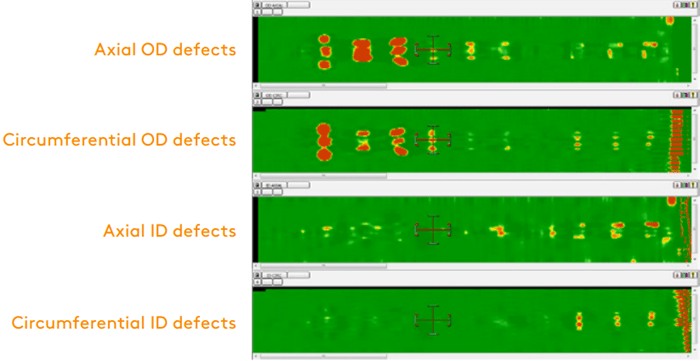Finding Hydroforming-Induced Cracks in Pipe Liner Welds
Some Carbon Steel (CS) pipes must be lined internally with seam-welded Corrosion-Resistant Alloys (CRA) such as INCOLOY to protect them from the very harsh nature of the chemicals they are meant to supply.
The Challenge
- Replace PT and MT in inspecting the weld and HAZ of hydroformed CRA pipe lining.
Cladding CS pipes during manufacture with 3.3 mm (0.13 in) thick seam-welded INCOLOY® 825 is performed, in this case, using a process called hydroforming. It pressures the cladding against the inner diameter of the CS pipe. Unfortunately, this can cause cracking in all orientations in or around the weld.
This application involved inspecting 14 km (8.7 mi) of lined pipe, broken down into 12 m (39.4 ft) sections, for a total of 1,167 pipes. The inner diameter (ID) of the pipes ranges between 203 mm and 305 mm (8–12 in). The welds to be inspected are approximately 3–8 mm (0.118–0.315 in) wide, 0.5–1 mm (0.020–0.039 in) high, and must be scanned in a single pass, including the Heat-Affected Zone (HAZ).
Previous inspections within the plant were performed with a mix of Magnetic particle Testing (MT) and liquid Penetrant Testing (PT). For practical reasons, these testing methods had to be dismissed for this application. Eddy Current Array (ECA) was considered to be an excellent alternative.
The welding used here is prone to splattering, which, once hardened, can be extremely jagged. The initial ECA probe used to inspect the cladding welds was badly damaged by the splatter. A new solution was therefore necessary. The solution was required to detect cladding ID and OD hairline cracks down to 10% of its thickness (0.33 mm/0.013 in) in all orientations.
The inspection solution must be able to perform this task at a rate of roughly one pipe per minute (scan speed approximately 200 mm/s or 8 in/s).
The solution must also be more rugged than its predecessor in order to withstand the wear from the spatter.
Due to added cost and complexity of a robotized solution, the customer wanted a semi-automatic solution.
The Solution
- Fast-turnaround, single-pass ECA inspection mechanism offering a higher PoD than PT/MT.
An I-Flex™ probe was modified for this application because of its capabilities. While its original interface was inappropriate, the technology behind the I-Flex still remained the best avenue for a solution to this challenge. The flexible probe was modified and mounted onto a carriage mechanism. It is designed to be attached to a rod so that it can be manually pushed and pulled at near constant speeds.
Six retractable arms are attached to the carriage’s hub. They can easily be adjusted to the cladding’s ID at the turn of a knob, which minimizes the turnaround time between pipes. The arms are designed to fit the diameter range in this application, but the concept is scalable.
The flexible probe is mounted on a shoe that is itself mounted on a suspension mechanism. It compresses the probe over the weld under test, minimizes liftoff, and increases Probability of Detection (PoD). A rough adjustment is performed, and then spring-loading is released by pulling a simple screw.
The click-on encoder makes it very simple to locate defects along a weld’s length.

Finally, a replaceable titanium shield covers the probe to protect it against the welding spatter.
The solution has proven itself successful in repeatedly detecting previously undetectable defects at the cladding’s OD, as demonstrated by the scan results below.

Benefits
- 40x faster, repeatable manual inspections with intuitive reporting and no chemicals.
Using this inspection solution has the following benefits:
Productivity gains
Inspect INCOLOY welds and HAZ in one minute (about 40 times faster than PT or MT) with a turnaround of under five minutes.
Improved PoD
ECA enables detecting previously undiscovered defects at the cladding’s OD and sizing them.
Repeatability
The overall simple operation of the solution ensures repeatability across the entire inspection project.
Better reliability
Single-pass scanning with intuitive C-scan imaging.
Accountability
Full data archiving to back up inspection results.
Health and safety
ECA, unlike PT and MT, does not need any chemicals, resolving several H&S issues.








